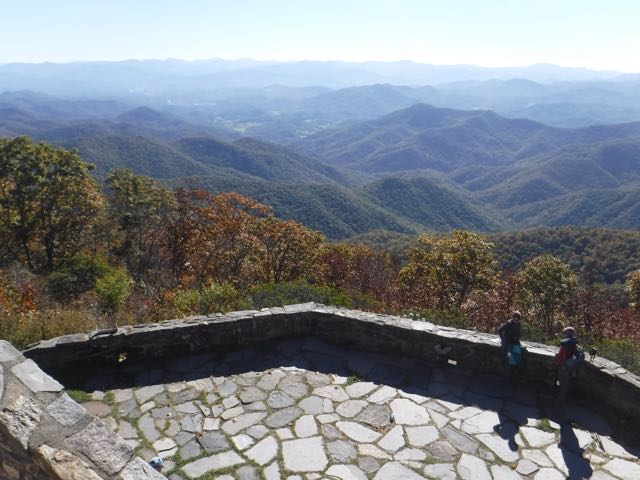
When National Forest Service officials hold their first public meeting Monday on the proposed management plan revision for the Pisgah and Nantahala National Forests, it will be the first opportunity for the public to weigh in on how the forests are run over the next 20 years.
Make that the public’s first official opportunity to weigh in.
Last year, when NFS officials indicated the revision might open 700,000 acres — about 70 percent of the million-acre woods — to logging, reaction was swift. A letter-writing campaign orchestrated by Wild South, an Alabama-based non-profit advocating public lands protection in the region, flooded the Forest Service with more than 1,100 letters. The federal agency charged with managing 193 million acres of federal forests and grasslands nationwide has since throttled back.
And the last time the Nantahala/Pisgah management plan was up for review, in the early 1990s, a torrent of public feedback caused the NFS to go back to the drawing board five times. What resulted, says Dr. Gary B. Blank, associate professor in the Department of Forestry & Environmental Resources at N.C. State University, was a management plan that cut back on logging in certain areas, placed increased emphasis on recreation, and added more potential for old growth forests.
“It took eight years to finish the plan,” says Blank. “Typically, it’s a three-year process.”
20-year game plan

The management plan sets the tone for how the forests will be managed for two decades. How much timber will be sold, how the recreational potential will be developed, how the forests’ long-term health will be assured. Basically, how the Forest Service will fulfill its mission of sustaining the health, diversity and productivity of the nation’s forests and grasslands and live up to its motto of “Caring for the Land and Serving People.”
It’s a tall task. As the Forest Service readily admits, “Some activities are compatible. Some are not.”
This time around, preservation and recreation advocates are in a stronger position than when the management plan, created in the 1980s, was last revised.
“Logging was an important part of the economy when the last plan was written,” says Sam Evans, staff attorney with the Southern Environmental Law Center in Asheville, “and it still is important for some sectors of the economy, but that sphere is shrinking fast.
“Logging produces some direct economic benefits,” he adds, “but recreation is now the biggest economic driver in the area.”
According to the Forest Service, recreation — including hiking, camping, mountain biking, whitewater paddling and rafting — on its lands contributed about $11 billion to the western North Carolina economy between 2008 and 2012. During that same period, just $703.6 million in timber sales were recorded in the Nantahala and Pisgah national forests. Timber sales from the forests have been on the decline since 1978-1981, when they peaked at $7 billion.
(Timber sales alone do not reflect the total economic impact for the industry, notes N.C. State’s Blank. Other factors include jobs in the logging and sawmill industries and, to a lesser extent over recent years, in the furniture industry.)
Roadless inventory part of the process
Another critical element of the current management plan is the inventory of lands that are essentially roadless and undeveloped. The inventory must be updated with every revision. From it, the Forest Service can identify candidates for Wilderness designation.
“Compared to its high level of wildland acreage,” says Evans, “the Nantahala-Pisgah actually has very little protected wilderness, so this is an opportunity to meet ecological and social needs for wilderness.”
Currently, the Pisgah and Nantahala forests have six wilderness areas totaling 70,530 acres, according to Wilderness.net. (Pisgah: Linville Gorge, 11,651 acres; Middle Prong, 7,842 acres; Shining Rock, 18,479 acres. Nantahala: Joyce Kilmer-Slickrock, with 17,410 acres; Southern Nantahala, 11,731 acres (with an additional 11,633 acres in neighboring Georgia) and Ellicott Rock, with 3,416 acres in North Carolina (with another 4,880 acres in adjoining Georgia and South Carolina).
From the most recent inventory, Wild South is advocating for a dozen new Wilderness Areas totaling 88,000 acres, as well as two National Recreation Areas totaling 220,000 acres.
Don’t get your hopes up for new wilderness areas any time soon, cautions N.C. State’s Blank.
“Wilderness is forever,” he says. “Once an area is designated Wilderness, it’s locked up forever.” Meaning no prospects for economic development, outside the tourist dollars of a handful of backpackers and hikers who explore the backcountry. (Of the 160 million visitors to national forests recorded between 2008 and 2012, about 5 percent went into wilderness areas, according the NFS.)
The Forest Service can recommend an area for Wilderness, says Blank, but final designation comes from Congress.
“And the current Congress,” he says, “isn’t going to do that.”
(The Hemingway-Boulders, White Clouds, and Jim McClure-Jerry Peak wildernesses in central Idaho were designated by Congress on Aug. 7, the first Wilderness areas designated by Congress since 2009.)
All the more reason, perhaps, to make your wishes known during the management plan’s public comment period.
“It’s a complicated, lengthy, bureaucratic process, but there are some intermediate points where it’s very important for the public to be involved and let their preferences be known,” says the Southern Environmental Law Center’s Evans. “One of those points is happening now, with the ‘potential wilderness evaluation.”
* * *
Your forests, your thoughts
The following Public Meetings are scheduled for this month:
- Monday, Nov. 9, 6-8 p.m., Tartan Hall, 26 Church St. Franklin
- Monday, Nov. 16, 6-8 p.m., 2015 Mountain View Room, Kimmel Arena, University of North Carolina Asheville, 1 University Heights, Asheville.
From there:
- Spring 2016: Public review of Draft Environmental Impact Statement, with 90-day comment period.
- Summer 2016-Spring 2017: Forest Service responds to comments, finalizes plan and final EIS, releases draft decision
- Spring/Summer 2017: Objection process
- Fall 2017: Final decision issued.
